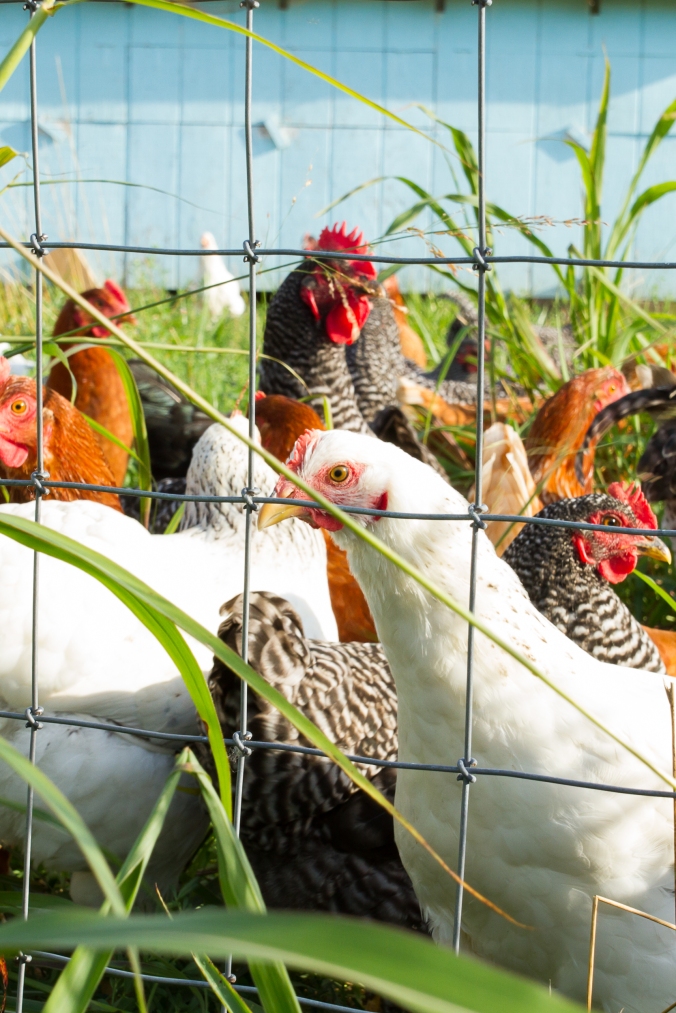The pretty pictures are by Sami Roy Photography!
Thanks, lady!
Dear frugal,
On the farm, we try not to waste food. I say try, because sometimes, despite our best efforts of selling all day and canning all night, a bin of peppers goes soft and is hauled out to the chickens.

Not a total loss, but still.
Any time we work with fruit, it’s an automatic assumption that the scraps will be made in to vinegar. It feels prudent, it makes a delicious vinegar for pennies, and it wastes not! Keep your shelves stocked with creative blackberry, blueberry, strawberry, mixed apple or peach vinegar – not flavored, but actually made from the fruit!
Besides looking fancy, there are purported health benefits to vinegar, too. Without stretching beyond the limitations of proven effects, we know that vinegar helps with mineral and calcium absorption – so it makes a natural, and great addition, to salad dressings! All that calcium in your kale and greens, might as well make the most of it.
Vinegar is a solution of acetic acid (made by acetobacter aceti), and when you buy it at the store it has been watered down to the desired pH, usually about 2.4 – 3.4. As you’ll see in the following recipe, vinegar is a two-step fermentation process.
In the first step, sugar is converted to alcohol by good old-fashioned ethanol fermentation. You can use the sugars in fruit, grains (like barley), juice or cider, cane sugar, molasses, coconut sugar, honey, or any other source of sugar you can think of. The primary alcoholic liquid is where the finished vinegar usually gets its name, i.e. apple cider vinegar, red wine vinegar, malt vinegar. This can be done anaerobically, with an airlock or a tightly sealed container, or with just a cloth cover.
The second step converts the alcohol into vinegar: introducing live acetobacter to the liquid, as well as giving it oxygen – I cover it tightly with a cloth and it takes a few weeks, but commercial operations use bubblers and fans to make vinegar in a matter of days or even hours. Some fabulous vinegars sit in this stage for months or even years, like the beautiful balsamic vinegars that come from Italy. The acetic acid gives vinegar that familiar, distinctive sour note. You can use a live mother, which is a thin SCOBY (not a kombucha SCOBY, which is lactobacillus, but an acetobacter aceti SCOBY) that floats in, on or at the bottom of the liquid. If you don’t have a live mother, you can use a splash of live vinegar, such as Bragg’s Organic Raw Apple Cider Vinegar .
As you can see on a bottle of, say, white vinegar from the store, finished vinegar is watered down to about 4 – 5% acetic acid. Commercial operations make their acetic acid solution extremely strong – it would peel your skin off! – and dilute it for sale. I imagine this saves a lot of room in their vinegar-making rooms!
Fruit Scrap Vinegar from the Food Lab
Download the recipe to your computer
1. Coarsely chop organic strawberries and leaves, or use tops from hulling. Or use any fruit scraps, peels and bits.
2. Place in a glass container and cover with approximately twice the volume of sugar water, using a ratio of 1/4 cup organic white sugar to 1 quart lukewarm water.
3. Cover with a tight cloth (fruit flies love this more than anything), and stir daily to avoid mold growth.
4. Keep at room temperature – about 70F/21C. In a week or two (up to a month if it is very cold out), the scraps will have a heady, boozy aroma. This is the product of yeast and sugar fermentation, combined with the addition of oxygen.
5. Strain the boozy strawberry scraps out and discard. Transfer the liquid into clean glass container and add some Bragg’s Raw Apple Cider Vinegar with the Mother – about 1/4 to 1/2 cup is more than sufficient, even a few tablespoons will suffice. This introduces live acetobacter to the strawberry alcohol.
6. Cover the container with a cloth and let it rest for a few more weeks – two weeks or up to a month. After one month, the acidity of my vinegar had reached 3.3pH. Store-bought vinegars usually have an acidity of 2.4 – 3.4.
7. Strain the finished vinegar and remove to a clean bottle, and use the thin, filmy skin or “mother” (and you may have multiple layers depending on how long you left it), to start the next batch without the use of Braggs! If you leave your vinegar on the counter, it will produce another filmy skin (this is just fine!). I store mine at room temperature.
Variations: You can use any fruit scrap to follow this process – bruised fruit, pineapple skin, apple cores, peach peels, coconut flesh or coconut water – just don’t use moldy fruit.
Notes from the Food Lab: You can also make the boozy fruit in a closed container. I tried that for about four weeks in winter and it worked quite well; the ambient temperature in the room was about 40 – 55F.
Download the recipe to your computer
What else should we try to make into vinegar? I am always eager to try something weird. What have you tried making into vinegar, or what is something you have an abundance that you want to try? Has anybody done a banana vinegar?
Pucker up!
Mrs H
I’ll get the goods to you first on Facebook, as always
I post some seriously cute pictures here you’d better believe it





Pingback: Ginger Ice Cubes & Good Girl Moonshine Hack | Farm and Hearth
Pingback: Simple Kombucha Flavors (also the best you’ll ever have) | Farm and Hearth